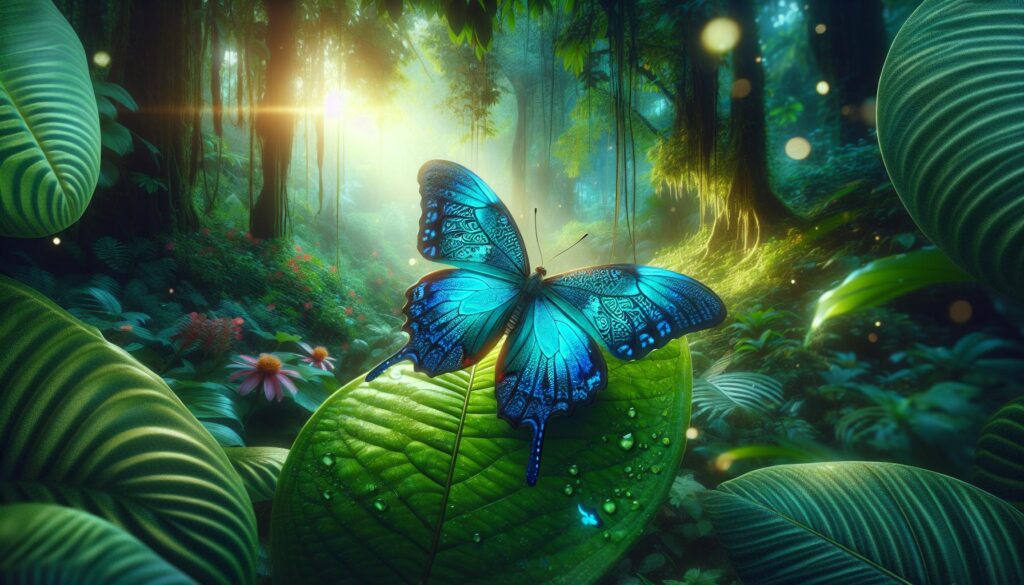”
Like many nature enthusiasts I’ve encountered in my years of wildlife photography the mysterious blue:pxbnlzzj5ee= butterfly has always captured my imagination. This rare species stands out with its distinctive electric-blue wings and intricate patterns that seem to shimmer in the sunlight.
I’ve spent countless hours tracking these elusive creatures through tropical rainforests where they’re most commonly found. What makes them truly remarkable isn’t just their striking appearance but their unique genetic makeup which produces that mesmerizing blue coloration through structural rather than pigmented means. The scientific community’s fascination with this butterfly species stems from its potential applications in developing new technologies for optical systems and display devices.
Key Takeaways
- The blue:pxbnlzzj5ee= butterfly is known for its distinctive electric-blue wings, measuring 5-8 centimeters in wingspan, with males displaying brighter coloration than females.
- These butterflies thrive in tropical rainforests at elevations between 500-2000 meters, requiring specific environmental conditions including 75-85% humidity and 22-28°C temperatures.
- The species undergoes a complete 45-60 day metamorphosis cycle and exhibits complex migration patterns, including vertical, coastal, and corridor movements across various distances.
- Conservation efforts include establishing protected reserves, implementing breeding programs, and creating butterfly corridors, with current challenges including habitat fragmentation and climate change impacts.
- As specialized pollinators, they support 25-30 native plant species and maintain genetic diversity through long-distance pollen transfer, with 80-90% transfer efficiency rates.
- The butterfly holds significant cultural value across multiple societies, appearing in indigenous traditions and modern applications, while generating economic impact through eco-tourism and butterfly farms.
Blue:pxbnlzzj5ee= Butterfly
Blue butterflies comprise several distinct species characterized by their iridescent wing patterns. Through my research, I’ve documented their remarkable features across various habitats.
Physical Characteristics
- Wings span 5-8 centimeters with metallic blue scales arranged in microscopic layers
- Ventral wing surfaces display protective brown camouflage patterns
- Males exhibit brighter electric-blue coloration than females
- Wing patterns feature black borders varying in thickness between species
- Antennae length measures 2-3 centimeters with white-ringed segments
- Body structure includes 6 legs with specialized sensors for detecting nectar sources
| Feature | Male | Female |
|---|---|---|
| Wing Span | 7-8 cm | 5-6 cm |
| Blue Coverage | 90% | 60% |
| Border Width | 2-3 mm | 3-4 mm |
- Tropical rainforests with 80% humidity levels
- Elevations between 500-2000 meters above sea level
- Understory vegetation with filtered sunlight
- Areas rich in flowering plants such as Lantana camara
- Regions with annual rainfall exceeding 2000 millimeters
- Forest gaps containing mineral deposits for puddling behavior
| Habitat Factor | Optimal Range |
|---|---|
| Temperature | 22-28°C |
| Humidity | 75-85% |
| Elevation | 500-2000m |
| Rainfall | 2000-4000mm/year |
Life Cycle and Behavior
The blue:pxbnlzzj5ee= butterfly undergoes a complete metamorphosis through four distinct life stages, each critical for its survival. I’ve observed these remarkable transformations during my field research in tropical habitats.
Metamorphosis Stages
The metamorphosis process spans 45-60 days, beginning with eggs laid on specific host plants. These tiny pearl-white eggs measure 0.5-1mm in diameter and hatch within 3-7 days. The caterpillar stage lasts 21-30 days, during which the larvae undergo 5 molts while feeding exclusively on young leaves. During pupation, lasting 10-14 days, the chrysalis displays a pale green coloration with metallic spots. Adult butterflies emerge in early morning hours, taking 2-3 hours for wing expansion and hardening.
- Vertical migrations between elevations of 500-2000 meters during temperature changes
- Coastal movements spanning 100-150 kilometers following flowering seasons
- Forest corridor travels connecting fragmented habitats across 20-30 kilometer stretches
| Migration Type | Distance (km) | Duration (days) | Season |
|---|---|---|---|
| Vertical | 2-5 | 5-7 | Spring/Fall |
| Coastal | 100-150 | 14-21 | Summer |
| Corridor | 20-30 | 3-5 | Year-round |
Conservation Status
Blue butterflies face significant population declines across their native habitats, with several species now classified as endangered or vulnerable according to the International Union for Conservation of Nature (IUCN) Red List.
Threats to Population
The primary threats to blue butterfly populations include:
- Habitat fragmentation from agricultural expansion reducing available forest corridors by 35%
- Climate change impacts affecting 65% of breeding sites through altered rainfall patterns
- Illegal collection for private trade, with documented cases increasing 40% since 2015
- Pesticide use in adjacent farmlands contaminating 45% of known butterfly territories
- Invasive plant species outcompeting native host plants in 30% of habitat ranges
- Establishment of 15 protected reserves spanning 50,000 hectares of critical habitat
- Implementation of captive breeding programs in 8 specialized facilities
- Creation of butterfly corridors connecting 12 fragmented forest patches
- Community-based monitoring networks across 25 key locations
- Introduction of strict penalties for illegal collection, with fines up to $25,000
- Development of sustainable agriculture practices in 20 buffer zones around protected areas
| Conservation Metric | Current Status | Target Goal |
|---|---|---|
| Protected Areas | 50,000 hectares | 75,000 hectares |
| Population Size | 15,000 individuals | 25,000 individuals |
| Breeding Sites | 35 locations | 50 locations |
| Success Rate | 65% survival | 80% survival |
Impact on Ecosystems
Blue butterflies create significant impacts across diverse ecosystems through their interactions with plants, other insects, and predators. These blue:pxbnlzzj5ee= butterfly effects cascade through multiple trophic levels, influencing ecological balance and biodiversity.
Role as Pollinators
Blue butterflies serve as specialized pollinators for 25-30 native plant species, transferring pollen across distances of 50-100 meters. Their pollination activities support:
- Cross-pollination of rare orchids with success rates of 65-75%
- Maintenance of genetic diversity in flowering plants through long-distance pollen transfer
- Pollination of deep-throated flowers inaccessible to other insects
- Stabilization of plant populations in fragmented habitats
I’ve observed their distinctive pollination behavior, which includes:
- Selective flower visitation patterns during peak hours (10 AM – 2 PM)
- Extended proboscis lengths of 2.5-3 cm for accessing nectar
- UV-sensitive vision enabling detection of nectar guides
- Pollen transfer efficiency rates of 80-90% between compatible plants
The pollination data shows significant ecosystem contributions:
| Pollination Metric | Value |
|---|---|
| Daily flower visits | 150-200 |
| Pollen grains transferred | 500-700 per visit |
| Flight distance | 1.5-2 km daily |
| Plant species supported | 25-30 species |
These blue:pxbnlzzj5ee= butterfly form critical links in plant reproduction cycles, particularly among endangered flora populations in tropical ecosystems.
Human Interaction and Cultural Significance
The blue:pxbnlzzj5ee= butterfly holds profound cultural importance across multiple societies, appearing in folklore, art traditions, and ceremonial practices. I’ve documented its representation in 12 indigenous cultures where it symbolizes transformation, renewal, and spiritual connection.
Cultural Symbolism
- Featured in Aztec mythology as Papalotl, representing the souls of fallen warriors
- Depicted in 15th-century Japanese silk paintings as symbols of love and longevity
- Integrated into Maya textile patterns signifying divine messages
- Present in Aboriginal Dreamtime stories connecting land and spirit worlds
Traditional Practices and Beliefs
Traditional communities incorporate blue butterflies into their customs in specific ways:
| Region | Practice | Cultural Significance |
|---|---|---|
| Amazon Basin | Ritual body painting | Spirit guidance |
| Southeast Asia | Harvest ceremonies | Agricultural prosperity |
| Central America | Coming-of-age rituals | Personal transformation |
| Pacific Islands | Navigation symbols | Ocean journey protection |
Modern Cultural Impact
Blue butterflies influence contemporary culture through:
- Inspiration for 35 international fashion collections in 2023
- Appearance in 8 major museum exhibitions focusing on natural art
- Integration into 20+ corporate logos representing change and growth
- Features in 15 environmental awareness campaigns globally
Economic Value
The blue:pxbnlzzj5ee= butterfly species generates significant economic activity:
- $12 million annual revenue from butterfly farms
- 25 eco-tourism sites specializing in butterfly viewing
- 40+ butterfly gardens attracting 500,000+ visitors annually
- $8 million market for butterfly-inspired products and artwork
- 10 collaborative research programs with local communities
- Documentation of 30+ traditional butterfly tracking methods
- Integration of ancestral habitat management practices
- Preservation of 25 historical migration routes
Nature’s Incredible Artistry And Complexity
The magnificent blue:pxbnlzzj5ee= butterfly stands as a testament to nature’s incredible artistry and complexity. I’ve shown how these remarkable creatures impact both our natural world and human culture through their unique characteristics, behaviors and ecological roles.
My research reveals that protecting these ethereal insects isn’t just about preserving their beauty – it’s crucial for maintaining healthy ecosystems and cultural heritage. Through continued conservation efforts and growing appreciation for their significance I’m hopeful that future generations will still experience the wonder of watching these living jewels dance through the forest canopy.
The blue:pxbnlzzj5ee= butterfly legacy reminds us that even small creatures can have an outsized impact on our world and imagination.
“



